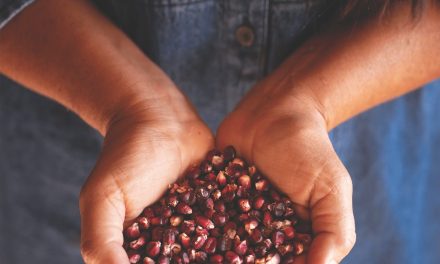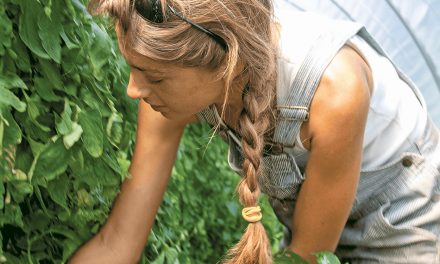Deep-rooted, small family farms provide
many functions in times of crisis
By Willy Carleton

Molly Manzanares trailing sheep through Carson National Forest at an altitude of approximately ten thousand feet.
Photo by Lara Manzanares.
Sometime in late August, I found a dead songbird outside my kitchen window. It was before such birds had made national headlines. I stared at its emaciated blue and yellow body for a clue of why it had died, idly concluding it must have simply flown into the window by accident. I made some coffee and went to work, nearly forgetting about it until well later when the news stories broke. A few weeks later, the image of that bird once again came to mind as I spoke with Sarah Wentzel-Fisher, executive director of the Quivira Coalition.
“What I worry is that the same thing is going to happen with family farms.” She let out a slight, nervous laugh at the sheer terror of such a statement before explaining further. “The mass die-off of those songbirds vacates a niche in the ecology that can have devastating ripple effects on the broader ecosystem. Here in New Mexico we have drought, migration and development pressure, lack of access to pandemic recovery resources, and limits to the market because of the pandemic, all of which put family farms here at a much higher risk.” The songbirds were a widespread warning that something was definitely not right in the environment, and, as Wentzel-Fisher sees it, family farmers, who serve critical roles in our communities and landscapes, are similarly showing signs of distress.
That conversation led me to other discussions with several farmers and ranchers and their advocates about the current state and function of family farms in New Mexico. I learned from those conversations that a bright side of this year has been that more families have converted their irrigated land to food production, and more small farms and ranches have filled in important supply chain gaps, revealing to many just how critical these farms and ranches are to our communities. Yet I learned too that the ongoing pandemic has strained an already fragile existence for many small family farms in New Mexico. Losing such farms would mean losing far more than simply a food or fiber producer. With intimate knowledge of their local landscapes, sometimes passed down from many generations, these farmers and ranchers are uniquely suited as climate change first-responders, cultural keepers, and community builders.
Don Bustos, who farms the same piece of land in Santa Cruz that his ancestors have farmed for over four centuries, likens the family farms of northern New Mexico to deep-rooted trees. “If you have a tree with deep roots, there are always sprouts coming out, little shoots coming out, and then there are seeds that are being spread all over the place. It acts as an anchor, as security, and acts as a buffer, too,“ he explained. “A multigenerational farm really helps anchor a community in several different ways,” he continued. “It’s a place for sharing knowledge, it’s a place to get resources, it’s a place of security knowing that there are farms like that in your community that can help support people. . . . It’s a first indication of what’s occurred in the environment. You can see it right on the ground, and that information gets passed around to other small farmers. So that’s community building happening. People come around; they come for matanzas, festivals, and celebrations. A lot of those are based around community, food, small farms, and agriculture.”
These varied functions of the family farm are precisely why Wentzel-Fisher is so deeply concerned about the future viability of multi-generational ranches and farms. “Part of what makes family farms invaluable is not just the food that they produce,” she said, “but the services they provide through generations of knowledge of how the land operates.” These ecosystem services, which might include a wide range of tasks, such as upstream erosion control, flood mitigation through acequia maintenance and operation, and fire prevention work, are often unacknowledged and unpaid. Such services will be critical as we face climate challenges ahead.
Gillian Joyce, executive director of the Alianza Agricultura de Taos, put it like this: “Our acequia agriculturalists and our riparian area producers are the best stewards we have. The capacity of our producers to increase water infiltration, and to help our aquifers and our rivers is huge. They are the most important first responders to climate change we have.”
This year has brought a unique strain on our state’s multigenerational small farms. With many families who were already marginalized struggling right now, Wentzel-Fisher said, “the combination of all the various factors of this year are really setting us up to have a loss of family farms, particularly in northern New Mexico.” Those factors span from an extreme drought that has dried acequias throughout northern New Mexico to pandemic-related market limits for farmers, processing backlogs for ranchers, and an overall lack of access to government recovery resources.
Tyler Eshleman, coordinator of New Mexico Coalition to Enhance Working Lands, explained a few of the challenges for producers in the region. “The COVID-19 pandemic has highlighted for us the challenges around lack of adequate processing, cold storage, and transportation infrastructure across the state,” he said. “Many farmers and ranchers lost their markets or experienced significant disruptions in their supply chains. This has meant energy and dollars had to go toward developing new markets that may or may not last beyond the pandemic—time and money most family operations don’t have.” Ranchers, he added, “have been hit particularly hard—many experiencing current delays in getting appointments with processors. . . . This means spending money feeding animals or maintaining lands to hold animals during a drought. It’s expensive.”
One such cattle rancher is Emily Cornell. A thirty-year-old rancher outside of Wagon Mound, Cornell began leasing part of the family ranch last year to begin her own cattle business, Sol Ranch, that is committed to regenerative, soil-building ranching practices. “Once COVID hit and the beef prices dropped, a lot of the conventional ranchers started booking up slots with processors,” she explained. “So that’s put a huge strain on any sort of grassfed business that is dependent on those small processors.”
Despite the current struggles, Cornell related an appreciation for being able to build off her parents’ knowledge of the land to grow her business. “I’m getting a chance to really do the planning on the landscape, [such as] where we want fences and water, and how do we need to rest our riparian areas and things like that,” she said. “And I feel like I get to inherit the know-how of how to do that, to some extent.”
For Cornell, being a business with family connections has meant not only sharing knowledge, but being close during a difficult time. “I don’t live with my parents, but they’re just down the road, and we help each other quite often with cattle work and various things. . . . I think our generation [is] used to dispersing from our parents and from the places where we grew up, and I never really thought much about coming back. But I’m appreciative now, knowing that I can help my parents, and I get to spend time with them and learn from them and, as crazy as that seemed at one point that I would want to do that, I’m appreciative of that opportunity [now].”
Such family relationships are often critical to New Mexico’s ranching business, where, according to a 2017 study, “the family supplies most ranch labor, and a majority of ranchers (70 percent) have been in the lifestyle for over sixty years.” An aging farming population, exacerbated by high land prices for farm and ranch land, only makes young farmers and ranchers such as Cornell more important to the state’s agricultural future.

Increases in land prices have been yet another effect of the pandemic on farmers and ranchers in some parts of the state. In Santa Fe county, for example, land prices jumped 69 percent in the second
quarter of 2020, according to Santa Fe Association of Realtors. Jarred Conley, owner and broker with the New Mexico Real Estate Group, specializes in land sales in northern New Mexico. Conley explained to me that interest in irrigated farm land in the area is high and that, unlike in previous years, much of the interest has come from people with little or no background in agriculture. “I’ve probably had more calls for irrigated land for farming since COVID started than I’ve had in ten years,” he said. “We have a very limited supply of irrigated land available, which is the only factor preventing an increase in sales right now.”
Added interest in land and increased land prices only increases the development pressure on family farms. Joyce explained: “For a lot of our legacy agricultural families, the generational wealth that they have to pass on is land. . . . When your wealth is in land and the labor market contracts [due to the pandemic], then the thing you turn to is your land, particularly when we’re seeing a ridiculous inflation of property prices. So logically, we may see that more as we go into winter. Particularly when people are looking at their land and saying ‘Man, I can’t even irrigate it,’ this is a perfect storm for increasing the rate at which agricultural land is lost under development.”
For many farmers and ranchers throughout northern New Mexico, an increase in development pressure, which has long been an issue in the region, adds cause for concern. And yet, for a long time, family farms and ranches have been in decline in New Mexico, where the rural population has steadily dropped from 43 percent in 1980 to 33 percent in 2015. The decline is evident to many in rural communities, such as Antonio Manzanares, who owns Shepherd’s Lamb in Tierra Amarilla with his wife, Molly Manzanares. Antonio describes seeing such pressure in his valley for a long time now.
“You know,” he said, “I can count on one hand in this whole valley, from Chama all the way to Canjilon, the folks that still make their living from agriculture.” Shepherd’s Lamb is one of a handful of full-time sheep producers in New Mexico, where raising sheep had once been commonplace. Antonio’s voice was quiet and calm, with a mix of dry humor and realistic concern, as he considered what lies ahead for his ranch and the valley he has grown up in.
“If our kids aren’t going to do it, what’s going to happen? We don’t really want to sell the ranch, but are we going to be forced to? And what’s going to happen then? Are they just going to build homes on it? Subdivide it? Or is someone going to come in and buy it as a small ranch? I don’t know.” Antonio started the sheep business with Molly on land that had belonged to his grandfather. Starting with fourteen sheep, together they slowly started to grow their business and built the herd to roughly one thousand ewes. “My wife and I discuss these kinds of things all the time, and we wonder, well, why are we working so hard, and what’s going to happen, and do people really care anymore? Or is it just all about what’s in it for me, not what’s in it for everybody else or the community? And this community is really deteriorating. You come to TA [Tierra Amarilla] and you see all the buildings falling down, you wonder what it’s going to look like fifty years from today.”

Top left, clockwise: Toni Broaddus and horse Shorty lead a semitruck through the flock during the annual fall sheep drive; Molly and Antonio Manzanares showcase Shepherd’s Lamb at the Santa Fe Farmers’ Market; Churro sheep at feeding time; tapestries made with Shepherd’s Lamb Churro weaving yarn. Photos by Lara Manzanares.
There are several ways to support family farms, ranging from contributing to local land trusts, voting for public officials who will create public initiatives to increase local markets through procurement programs, and, of course, purchasing directly and indirectly from local farms and ranches. As Cornell expressed to me, “It seems to make sense for me that people wanting to make a positive impact on the environment and their local landscape support the local ranchers and farmers that are doing this work. . . . We don’t always want to thump our chests and say, ‘Look at what I did. I built these rock structures and fixed this erosion,’ but maybe that’s what we need to do because maybe the consumer isn’t aware that there’s a ranch nearby that’s doing this work, and that they could contact each year for their beef, and that they could see the ranch and see the animals and have a relationship with that producer and build that relationship that’s built on mutual trust and understanding that we’re doing the best we can to honor their values as well as our own.” Cornell, who was busy watering her cows as we talked, moved out of reception briefly before cutting back in. “And that’s something I’d like to see come out of this.”
Such support for New Mexico’s small farms and ranches, especially those built on multigenerational knowledge, has never been more important. These farms provide much more than food and fiber; they help hold together both community and ecosystem. After my conversations with these farmers and ranchers, the image of the songbird outside my kitchen window once again entered my mind. I thought back to an analogy Don Bustos made for family farms in New Mexico, as he described how farmers are often the first to see environmental distress in their landscapes and economic distress in their communities. “We’re like the canary in the cage, man,” he said toward the end of our conversation. “If we go down, New Mexico will go down.”
Edible celebrates New Mexico's food culture, season by season. We believe that knowing where our food comes from is a powerful thing. With our high-quality, aesthetically pleasing and informative publication, we inspire readers to support and celebrate the growers, producers, chefs, beverage and food artisans, and other food professionals in our community.
















